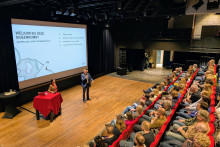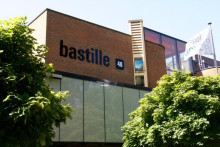Communicating scientific and technological developments in an effective way requires intelligence, rhetorical skills, charisma, and, most of the time, a creative use of props. This is what the seven participants, students and researchers, had to demonstrate to a jury composed of deans, professors and students.
The winners
The first announced winner Geert Folkerstma, a researcher at the Robotics and Mechatronics department, began by showing the audience a stuffed cheetah while introducing his theme of nature-inspired robot designs. To draw attention to the relevance of the cheetah’s flexible spine in its rapid and efficient movements, Folkerstma started playing with a rainbow-colored spring.
Internet security specialist José Cardoso de Santanna, the second winner of the night, illustrated a DDoS attack by pouring a big jar of Smarties in a wooden box with so much enthusiasm that some of the candies ended up rolling over the floor. He then explained how the piece of software he had written could differentiate legitimate requests from malicious ones, prompting him to grab smarties’ packages from the wooden box and throw them to the audience.
The challenge
Contestants had to summarize their topic of choice and pitch it to the audience in three minutes. The jury would then ask questions about the topic for two more minutes. The content of the pitches was focused mainly on each of the young scientists’ area of research, which included their latest findings in water management, materials engineering, robotics, and computer science.
Trying hard to captivate the public in a matter of seconds, some participants found themselves stuttering and losing track of their pitches. A few finished before their time was up, but the ones who surpassed their time limit would be surprised by a bell ring.
What’s next?
The two winners will continue to compete in the national contest of FameLab, and if they’re lucky, they will be able to go to the Cheltenham Science festival and compete in the finals against other 30 countries. Humour, metaphors, and props might help them become the next big science communicators.







